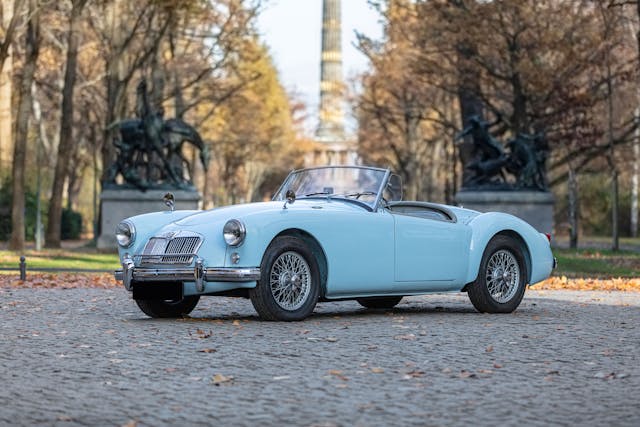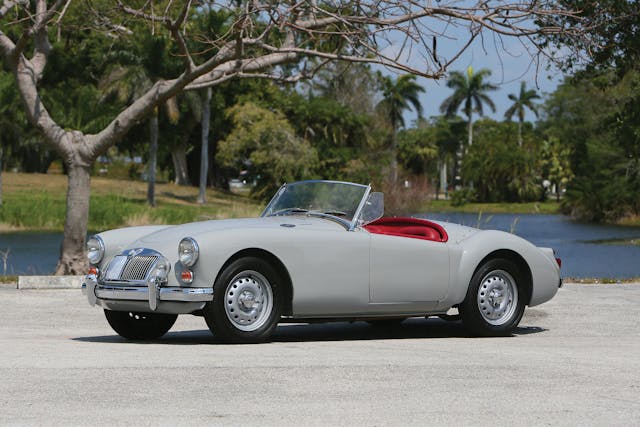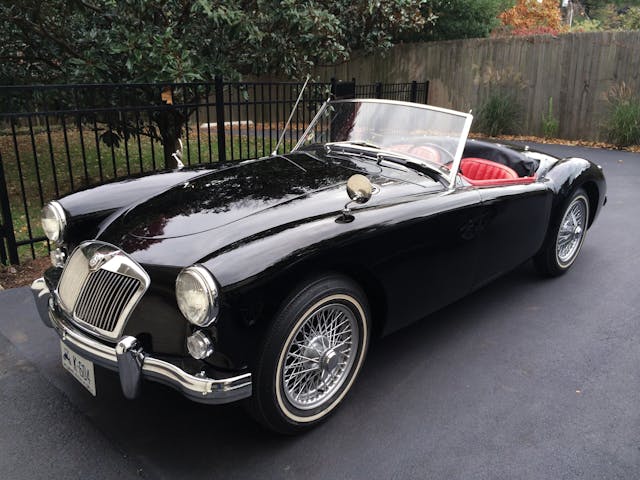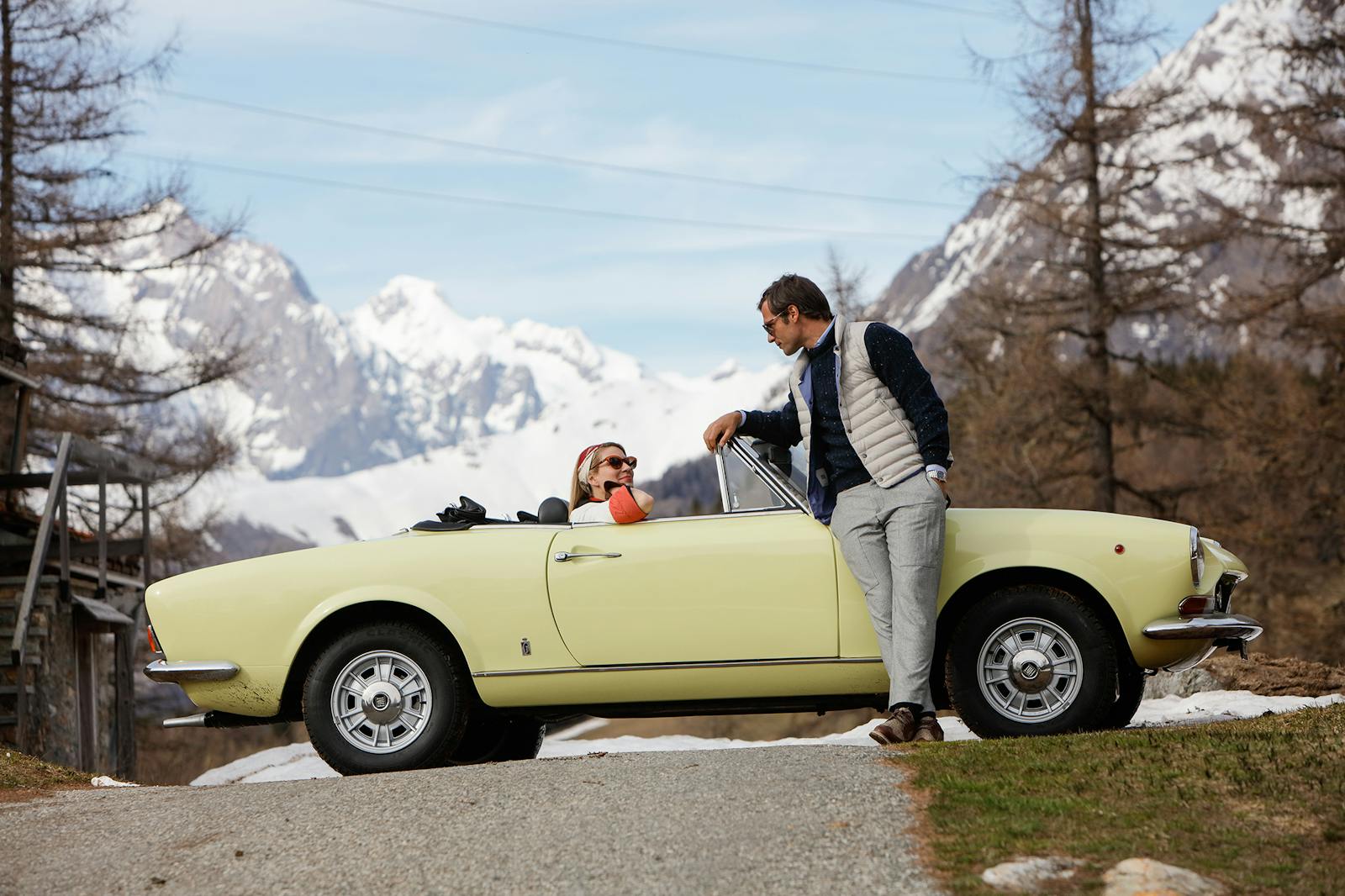Your handy 1955–62 MG MGA buyer’s guide
MG was a sports car manufacturer in dire need of a new shape by the 1950s. While most automakers adopted streamlined ponton styling over the previous decade, MG was still selling its T-series roadster, a shape right at home in the open-fendered 1930s. Everything changed in 1955, as the achingly beautiful MGA made its debut, complete with a low-slung chassis and integrated coachwork. And the MGA experience is probably why you are interested in owning one.
Model overview
1955
It might be hard to believe that the MGA began life as a race car designed for the 1951 running of the 24 Hours of Le Mans. The car’s lines first appeared on a rebodied, factory-designed version of the MG TD run by a privateer that year. The subsequent top-speed bump over the TD justified further development. Four other prototypes (dubbed EX182 by the factory) ran at Le Mans in 1955, and by September of ’55, the production MGA was ready to be launched.
The MGA shared numerous parts with the outgoing T-Series, but the lower-slung new car initially came with a more modern engine: Early MGA roadsters were powered by a version of the 1489-cc (1.5-liter) B-series engine from MG parent company BMC, with twin SU carburetors and 68 hp. Shortly afterward, the B-series received a power bump to 72 hp. A total of 1003 roadsters were made in this first year of production.

1956
The following year saw the introduction of the MGA coupe, with its signature steeply curved rear window. The gauges were simplified, now sporting a cleaner design and fewer numerals on both tachometer and speedometer. A total of 13,394 roadsters and only 16 coupes were made this year.
An aluminum hardtop was now available for the MGA roadster, made by coachbuilder Vanden Plas, and finished in black with a white vinyl headliner. Later tops (1960 and up) were made of fiberglass by Universal Laminations. UL sold these tops as an aftermarket accessory before receiving MG’s blessings for factory availability.
1957
No significant changes occurred this year, with an impressive 16,467 roadsters and 4104 coupes produced.

1958
Enter the MGA Twin Cam, the top of the MGA food chain. While all MGAs received a revised bonnet this year—the Twin Cam’s taller engine demanded it—new “Twin Cam” emblems were added to highlight the extra power, the new and specially developed cylinder head for the trusty B-series, and the lightly modified chassis. This 1.6-liter, high-compression (9.9:1), twin-camshaft, aluminum head, twin-SU-carbureted motor was good for 108 hp. Available in both the MGA roadster and coupe, the twin-cam engine offered performance so impressive that Girling four-wheel disc brakes were fitted as standard. Center-lock Dunlop wheels replaced the stock four-lug steel wheels or optional wires, while a vinyl-covered dash face and unique seats set the interior apart.
The twin-cam engine unfortunately carries a mixed legacy. Although intended as an engine upgrade for racers and knowledgeable performance enthusiasts, MG’s most exotic powerplant found itself in the hands of owners with no experience with temperamental engines. Early issues with detonation (and subsequent engine failure) were later addressed with lower-compression pistons (8.3:1) and modified ignition timing, at the expense of a few horsepower. In this trim, Twin Cams became far more reliable, but the changes were too late—the reputation was set, and sales never really took off.

1959
For 1959, a new, 1588-cc (now 1.6-liter), 80-hp version of the B-series engine replaced the older, 1.5-liter unit, and a new name entered the fold: 1600 Mk I. Available in both coupe and roadster bodies, 1600 Mk I MGAs offered front disc brakes (drums remained in the rear) and a few minor trim changes. A new 1600 DeLuxe version was situated between 1600 and the Twin Cam, designed to use up excess Twin Cam components. The DeLuxe offered that car’s Dunlop wheels, four-wheel discs, vinyl-topped dash, but with the B-series engine from the ordinary 1600.
The Twin Cam soldiered on for this year, gaining an optional close ratio gearbox. It’s been suggested that sometime in 1959, MG added “1600” emblems to the bonnet and decklid, and revised taillights with an individual lens for the turn-signal light. It’s possible that many 1959 models did not receive them, but these changes were nonetheless commonplace by the 1960 model year. There were significantly fewer 1.5-liter roadsters (6803) and coupes (841) made this year, but that was offset by the number of Mk I roadsters (12,938) and coupes (1218) sold.

1960
The ill-fated Twin Cam model bid farewell this year, but the DeLuxe remained for owners looking for more from their quintessential British sports car. A full 15,478 roadsters and 1452 coupes were made this year.

1961
A second-generation MGA, the 1600 Mk II, saw production with a larger 1622-cc engine, a redesigned cylinder head, and an extra 10 hp, for a total of 90. The extra power allowed the Mk II to have a taller final drive ratio (4:1, down from 4.30:1) for easier cruising and improved fuel economy at higher speeds. Visually speaking, the Mk II had a new grille with recessed slats that didn’t follow the MGA’s contours. It also offered revised taillights mounted horizontally, a vinyl-covered dash, provisions for the mounting of seat belts. There were 314 Mk 1600 I roadsters and 101 coupes produced, while a more robust 5254 Mk II roadsters and 416 coupes were made.

1962
As MG made way for the upcoming 1963 MGB, the MGA marked time in its final year of production. Mk II production totaled 2944 roadsters and 105 coupes, leading to a final tally of more than 100,000 MGAs sold over eight years.
Before you buy
There are many reasons to own an MGA, but make sure to take a pause before splashing the cash—these cars can suck up repair and restoration money with the best of them, and a pre-purchase inspection is always wise. The biggest potential issue is corrosion, even if the MGA in question was restored in the past. Check everywhere: trunk corners, rear crossmember, rocker panels, in the floors where steel meets the wooden floor boards, battery brackets, firewall supports, under the lights, in the rear quarter panels, around the fender welting, and for corrosion between aluminum and steel components.
Make sure all body panels fit correctly (look for uniform gaps) and rock the doors up and down to ensure they are stable on their hinges. Check the “F-section” of the body, the sill and door post, for structural stability. There are a lot of body panels that make an MGA, and it’s likely any MGA for sale has aftermarket panels added to repair rust or collision damage. When in doubt, pay the money for a pre-purchase inspection for true peace of mind.

Happily, the MGA’s B-series engines are tough and durable. Examples with higher miles and poor maintenance might have high oil usage, with noisy bottom ends and worn cam bearings often the root of low oil pressure. The twin-cam engine got a bad rap in the past but is now desirable; the design’s issues were long ago sorted, and the cars make excellent weekend or road-trip drivers. Gearboxes on all models often weep oil and suffer from worn synchros but are otherwise quite reliable.
MGA interiors are minimalist and somewhat durable, though materials like leather and wood require periodic upkeep to look their best. The original MGA carpets were short and bristly, making them relatively hard to clean, and they tended to hold in moisture. The under dash cover was cardboard-like and rotted if enough water came in from above the dash, especially on a roadster. Speaking of roadsters, their hinges often wear on the top of the folding roof’s frame.

The MGA’s optional knock-off wheels (either wires or those Twin Cam or DeLuxe Dunlop steels) require a unique axle in back and a hub swap in front, so if you want a car so equipped, look for one already wearing knock-offs; changing to them is not a small process. Along the same lines, the pin-drive Twin Cam wheels are similar to those used on Jaguar’s D-Type—some Twin Cams have been converted to wires or ordinary steels, and sourcing correct wheels can consume time and cash.
Because parts readily interchange between many BMC vehicles, it’s easy to modify an MGA without anyone knowing, and numbers-matching setups are easy to fake. Reproduction parts are plentiful and many are affordable. Significant modifications include retrofitting MGB blocks for the B’s five-main bearing crankshaft and extra displacement, with little downside: the modifications are period-correct and significantly improve performance. Overdrive transmission conversions are also plentiful, as MGAs with a stock gearbox aren’t terribly suited to modern roads: parts are readily available for the Ford/Merkur T-9 and Miata gearboxes.

Valuation
The Hagerty Valuation team has gained insight into recent transaction prices, but please check here for the most up-to-date values. Like many classic British sports cars, MGA prices remain fairly quiet but did surge a bit in the latest Hagerty Price Guide update on May 1, 2021. Looking at all MGAs, the median #2 value is up 14 percent over the past 10 years, and up just 2 percent over the past five years. Going further back in time, MGAs dipped after the last recession and haven’t quite recovered to their pre-2008 levels. Values are down 4 percent since 2008.
The gap between #1 and #2 cars and #3 and #4 cars has grown and will likely continue to grow. We’ve seen this trend across many classic British cars, as people like the style and the driving experience, but are willing to pay more for a properly restored machine with fewer issues. Our median quoted value for all MGAs is $22,200, and that figure is up 10 percent over the last five years. (The number of quotes is up five percent over the past five years.)
Demographically speaking, pre-boomers quote 13 percent of MGAs and make up seven percent of the market. Boomers quote 61 percent and make up 39 percent of the market, while Gen Xers quote 20 percent with 31 percent of the market. MGBs are considerably more popular with younger buyers, as millennials quote six percent of MGAs and are 18 percent of the market.
The MGA’s combination of elegance, performance and value is tough to beat, but the universal truth of buying a classic car remains: Buy the best condition and best maintained example you can afford. Happy hunting.

